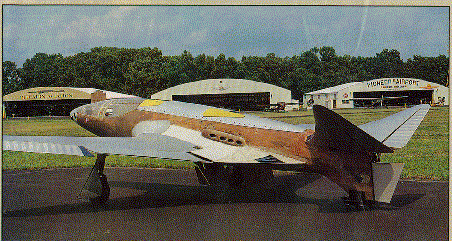

Editor: Jaap Horst

The first Bugatti design was a single-seater, single engined race-plane, to take place in the 1938 Deutsch de la Muerthe Cup. As the T50B engine had only limited power, compared to other aircraft, the airframe design should have minimum drag. So the cockpit had to be faired into the sleek fuselage lines, and the engine was mounted behind the cockpit, at an angle to allow the driveshaft to go alongside the pilot.
It was at that stage that it was decided that the aircraft would lack power, and the weird solution was found, to put in another engine, behind the other! So two driveshafts were used, one on either side of the pilot. This is the design that was finally built. However with this, the engine capacity would rise above 8 litres, the maximum for the coup Deutsch. The Model 100 would have to attack the absolute World speed record!
The French Air Ministry looked at the project with interest, and gave Bugatti a contract for a light pursuit version of this aircraft, this was called the 110. The contract carried the stipulation that, if the World Air Speed record should be broken with the Model 100 (709km/h at the moment, and 634 km/h over 100 km distance) a premium of 1.8 million francs would be awarded.
It may look an attractive plane, however it is doubtfull if it would have been a useful fighter with the extra weight of guns, amunition etcetera.
Reason for the contra-rotating propellor design was to reduce drag! An aircraft with this power, would have required much larger tail surfaces to control engine torque on takeoff, if it had been equipped with a single propellor.

The aircraft itself was built in a fine furniture factory at Paris, and removed hastily when the Germans invaded the city, hidden in the French countryside, until the end of the war. A number of years after the war a Detroit automobile restorer (and obviously not a plane-lover), Ray Johnes, bought the aircraft to rob it from its engines. Lester Lefferts in Connecticut has been in the process of restoring the plane for static display (without the engines), with the help of Ron Lawrence. However lack of funds seems to have brought an end to developments, and the Model 100 went to the Airforce museum, however the restauration was not completed. Recently the aircraft was acquired (given to) the EAA Air adventure museum, and will be, finally, restored to the full.
Now we're only waiting for somebody to make a flying replica, and actually attack the world air speed record!


The construction of the fuselage is far from conventional. It is built up of a wood sandwich, buttressed by rectangular box sections. On this polyhedral frame, layers of balsa wood were glued, and then carved to obtain the aerodynamic shape. After shaping, hardwood rails were set into the balsa, to take concentrated loads around engine mounts, canopy etc. The fuselage was then covered with strips of tulip wood, to form the skin. After sanding the fuselage was covered with linen and dope.
The wing construction follows the same basic idea. A single box spar carries completely through the fuselage, making a one-piece wing. The airfoil was then built around the spar with balsa and tulip wood. All fuel was carried inside the spar.


Figure 1 shows the flaps in the normal cruise position, triggered by moderate airspeed and manifold pressure. When the sensors picked up low airspeed and high manifold pressure, the flaps would be set in the takeoff/climb position, figure 2, increasing the lift of the wing. At max. power and high airspeed, the drag would be decreased to a minimum, figure 3. Less lift would be available, but not needed at this high speed. Fig. 4 shows the dive brake position, triggered by high air speed and low power. For landing the flaps operated to increase lift and drag, figure 5, while the top flap would rise while applyng the brakes, after landing (Fig.6).

The landing gear was also connected to this system, and would lower (and rise) automatically. Furthermore the retraction system was set up to take advantage of the airstream once the aircraft had left the ground. The doors were toed in slightly and air pressure provided almost all the lifting power to raise them!

The engines in the Model 100 are not "simple" T50B engines! The T50B was too heavy, the aluminium block had to be redesigned and recast in magnesium. Also a special, leightweight, Roots supercharger was fitted. In the picture the engines can be seen, in the plane.
Advantageous of the T50B engine was that the crankaxle bearings were cast with the cylinder blocks, not with the carter. So the carter needed be only a sheet of metal, to collect the oil. Thus the weight of a normal carter could be avoided.
Dimensions of the aircraft:
Wing span: 8.23 m Length : 7.44 m Heigth : 2.23 m Wing area: 20.7 m*m Weight : 1389 kg Power : 900 hp Weight per hp: 1.54 kg Speed : 805 - 885 km/h


The plane as it was shown at the July 1996 event at Oshkosh.
For further reading, see the Bugatti Aircraft article in the Bugatti revue Vol.1, No.3
Become a member of the Bugatti Aircraft Association!